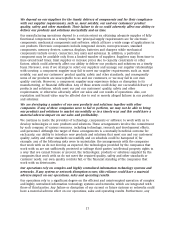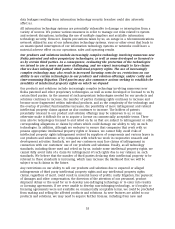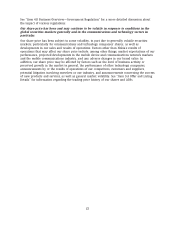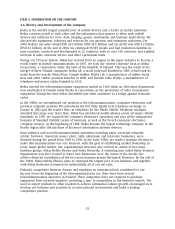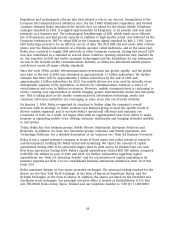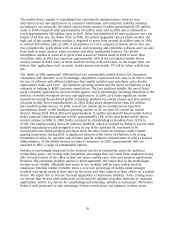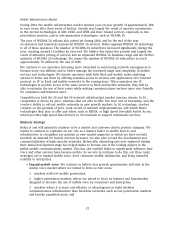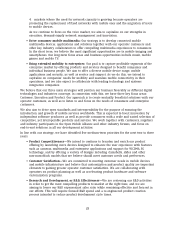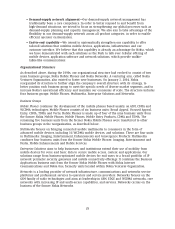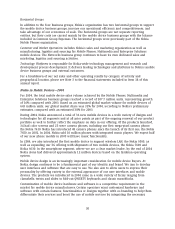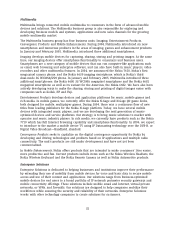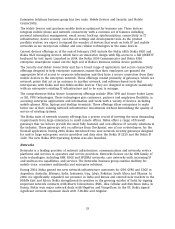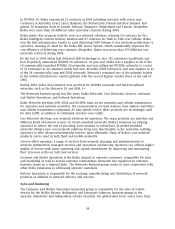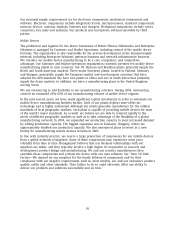Nokia 2004 Annual Report Download - page 28
Download and view the complete annual report
Please find page 28 of the 2004 Nokia annual report below. You can navigate through the pages in the report by either clicking on the pages listed below, or by using the keyword search tool below to find specific information within the annual report.Mobile Infrastructure Market
During 2004, the mobile infrastructure market showed year-on-year growth of approximately 14%
in euro terms after three years of decline. Growth was largely the result of operator investments
in the current technologies of GSM, EDGE, and GPRS and their related services, especially in low
penetration markets, and in new-generation technologies, such as WCDMA 3G.
The pace of WCDMA 3G rollouts also picked up during 2004, and by the end of the year
63 operators had launched commercial WCDMA 3G services. Nokia supplied WCDMA 3G technology
to 28 of these operators. The number of WCDMA 3G subscribers increased significantly during the
year, reaching around 16 million by year-end. We believe this subscriber growth was largely the
result of attractive pricing of services and an expanded WCDMA 3G handsets range and the further
maturity of WCDMA 3G technology. We expect the number of WCDMA 3G subscribers to reach
approximately 70 million by the end of 2005.
We continue to see operators becoming more interested in outsourcing network management to
become more cost efficient and to better manage the increased range and complexity of mobile
services and technologies. We foresee operators with both fixed and mobile assets exploring
options to better use them by offering seamless access to services and applications over Internet
protocol, or IP, in fixed and mobile networks in the coming years. When operators use IP
technologies to provide access to the same services in fixed and mobile networks, they will be
able to optimize the use of their assets while making communications services more user friendly
for consumers and business users.
Competition in both the 2G and the 3G network infrastructure market remains intense. In 2G,
competition is driven by price, solutions that are able to offer low total cost of ownership, and the
vendor’s ability to roll-out mobile networks in new growth markets. In 3G technology, vendors
compete on the grounds of price, track record of network implementations, and which future
technologies they plan to offer and when, such as HSDPA, or High Speed Downlink Packet Access,
which provides high speed data delivery to 3G terminals to support multimedia services.
Business Strategy
Nokia is and will primarily continue to be a market and customer driven product company. We
intend to continue to capitalize on our role as a market leader in mobile devices and
infrastructure to strengthen our position in new market segments in which we have recently
invested. As demand for mobile services increases, we also plan to lead the development and
commercialization of high capacity networks. Historically, expanding into new segments during
their initial development stage has helped Nokia to become one of the leading players in the
global mobile communications market. This has also enabled Nokia to significantly influence how
voice and other services have become mobile. As we aim to continue to do this, our three main
strategies are to expand mobile voice, drive consumer mobile multimedia, and bring extended
mobility to enterprises.
•Expand mobile voice: We continue to believe that growth opportunities still exist in the
mobile voice market where we intend to focus on four areas:
1. markets with low mobile penetration;
2. higher penetration markets, where we intend to focus on features and functionality
designed to increase the use of mobile voice by consumers and enterprises;
3. markets where it is more cost-effective or advantageous to build wireless
communications infrastructure than fixed-line networks, such as low penetration markets
and heavily populated areas; and
27


